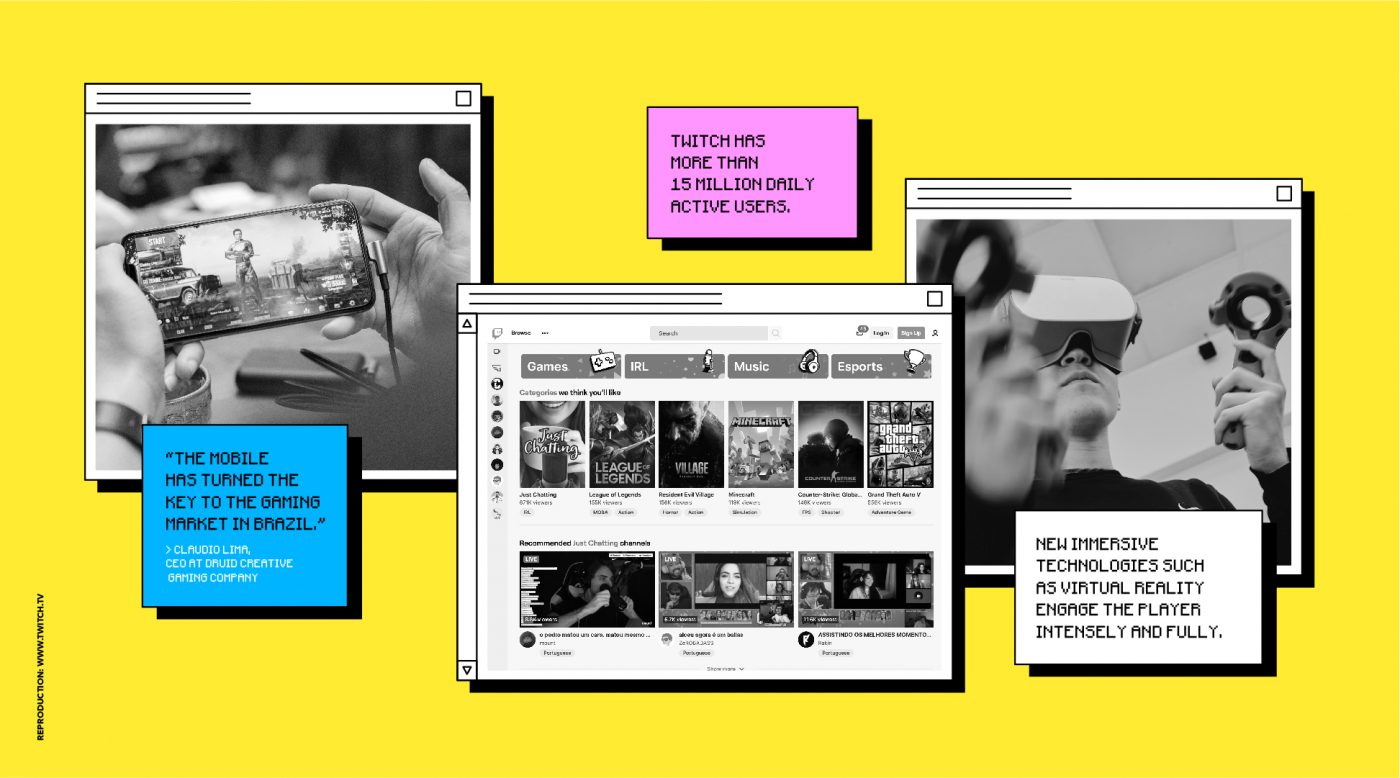
People have never played so much as nowadays. The fast-paced growth of the gaming industry triggered by the need to stay at home during the pandemic is making games win an increasingly diverse and wider audience. The figures are dizzying: in 2019, the market had a turnover of 1.5 billion US dollars in Brazil and 152 billion worldwide, leveraging more investments than cinema and sports. In 2020, electronic games were the most discussed topic on Twitter, with 2 billion tweets. What does this universe represent for brands and how can they play the game?

The mobile phone is the gateway
There is no doubt that games represent today for young people what music used to represent in the 90s: cultural identity and the feeling of belonging to a community. Games are intrinsically linked to young culture, today more than ever. But if your idea of a typical gamer is an antisocial teen geek, think twice. From Candy Crush to Fortnite, the profiles and ways to play are numerous, with games that fit everyone’s time and pocket, matching different lifestyles, personalities and interests.
According to the Pesquisa Game Brasil 2021 survey, 72% of Brazilians say they play electronic games, and most of them have played more online games since the beginning of the pandemic. The casual gamer is best represented by a woman between 25 and 35 years old, while the hardcore is usually a man between 16 and 24 years old. The survey also pointed out that almost half of the players are from the middle, lower and poor social classes. For all of them, the mobile phone is the choice of preference. This explains the success of games like Free Fire, available on mobile and with more than 100 million downloads. On the other hand, consoles are declining, much due to the exorbitant prices charged in Brazil. For Claudio Lima, CEO at Druid Creative Gaming, “the mobile has turned the key to the gaming market in Brazil. Playing was for upper-class individuals, it demanded a console or PC, and that was very expensive. Now, anyone can play. Kids today dream of becoming Free Fire players instead of becoming soccer players.”
It's not just about playing,
it's about watching too
In addition to playing, millions also watch other players, professional and non-professional, through streaming platforms that are growing non-stop – Twitch, for example, has more than 15 million daily active users. A global survey in 2020 pointed out that gamers between the ages of 18-25 spend an average of 4 hours a week watching other people online. This phenomenon is creating new types of influencers who play matches with their audience, sometimes hundreds in the same day, creating authentic bonds and a true closeness. The Brazilian gamer Cellbit, for example, has been recording videos for Twitch and YouTube since 2012, counting with more than 6 million followers, with a total of 300 million views.

Metaverses are the future
of entertainment
The gaming industry is shaping the future of entertainment, with varied and complex productions, immersive technologies and universes full of possibilities, besides impacting the streaming industry.
Immersive Games like Beyond Two Souls or Cyberpunk benefit from high-budget investments worthy of the biggest Hollywood productions, with the participation of the best writers, actors and artists. The result is the creation of incredible narratives, characters and soundtracks. New immersive technologies such as virtual reality engage the player intensely and fully, while augmented reality blurs the boundaries between real and virtual. And of course, in these universes, players have the possibility to do many other things: their avatars can watch music shows and spend their money in different ways, simulating the real world. Roblox, a very popular platform that allows users to create their own worlds and mini-games, aims to ”unite the world by building a metaverse (a virtual world that digitally replicates the real one), where millions can meet up in games, conferences, or in collaborative jobs within a virtual economy that has its own currency.”
Agencies and divisions
specialized in games
Many non-endemic brands, that is, those that traditionally have no market links with the segment, are entering this world, creating new market dynamics and generating new demands – internally and from their partners. Unilever has created an esports center to better meet the needs of its brands; Publicis Play, launched this year in the UK, brings together a pool of experts from the group to provide creative, media and production support to its customers. In Brazil, Druid started operations at the beginning of the year and seeks to creatively connect games and brands, through a Business to Gamer model.
How to play the game?
For traditional brands, entering the gaming world may seem scarier than it really is – but we believe there are far more opportunities than risks. However, entering this game is something that requires preparation, and before you even start creating content and activations, you need to build a solid strategy, consistent with the brand positioning and value proposition, to connect with audiences in an authentic way and not just as another product placer.
We’ve identified some ways in which brands can begin to relate to the gaming world, building bridges with communities to – lightly and unpretentiously – join the conversation:
- Playing with languages, aesthetics and references of the gamer culture: Amaro, for example, has launched a collaborative collection fully inspired by the characters of Animal Crossing. Starface is a cosmetics brand with a young and fun look and feel, inspired by the look of retro video games. Domino’s has been making several fun activations, such as featuring Pac-Man on their pizza boxes.
- Interacting and establishing dialogues with gamers, showing interest in getting to know this audience better, is also an option: famous celebrities are enjoying, for example, playing games interacting with the public or with influencers (gaining very high visibility in return, of course): Guilherme Boulos and AOC made lives playing Among Us, while Drake and Ninja’s live playing Fortnite broke audience records.
- Connecting with gamers through iconic products: Categories like fashion, and more specifically streetwear, have easily connected with gamers including their outfits in games. They also get inspiration from games to create unique collections in real life. Nike is an example of this approach. The brand started with a feature of the Jordan Collection sneakers in NBA video games, and now is outfitting some Fortnite characters and sponsoring the Chinese League of Legends team, with physical collections inspired by the game.
On the other hand, we believe that some initiatives, at first glance tempting, can in fact be much riskier or less impactful:
- Major brands are entering esports body and soul, but the risk of compromising the relationship with their audience is huge. For Claudio Lima, this is explained by the fact that e-sports are an easy-to-understand product: “Everyone understands what a football sponsorship is. There’s a team, there’s a T-shirt, there’s a crowd. But brands also have to deal with passionate fans, and sometimes with closed and protective communities. You cannot get in and out whenever you want, you can’t give the impression that you’re abandoning the team.”
- Other brands are creating their own minigames, and while it’s a fun way to create engagement, it’s more interesting to be where the audience is already playing than trying to compete with their favorite games. That is, instead of trying to create their own Animal Crossing, brands earn much more by participating in Animal Crossing.
Where is the market heading to?
As the pandemic subsides, the connections made by players within games will create opportunities outside of them as well. People who have met online will want to meet physically and show how they belong to the communities. Therefore, events will boom and meeting places, such as the famous Lan Gaming Centers, can revive.
Want to continue learning about games, gamer culture and their relationship with brands? We recommend the podcast marketin.gg, which investigates the relationship between games and brands and Netflix’s High Score, a docuseries which tells the story of video games in a fun way. Are you missing the first classic games? Check here how to get access to a number of retro games, for free. Stay tuned and read our article on gamification, or on how brands can apply the mechanics used in games.
Get in touch if you want to chat about the challenges and opportunities for your brand. And if this topic inspires you, and you are or know business professionals, strategists and designers who are interested in joining our team, write to [email protected] telling us about your expectations, goals and history. We are always in search of talent!
This article had the contribution of: Carmen Beer, Ana Cerqueira, Giuliana Sanchez, Thaísa Miyahara, Ana Paula Moreno, Josy Lamenza, Daniela Irrazabal, Rosario Maglione, Renato Storni, Luís Bartolomei, and the special participation of Claudio Lima.

